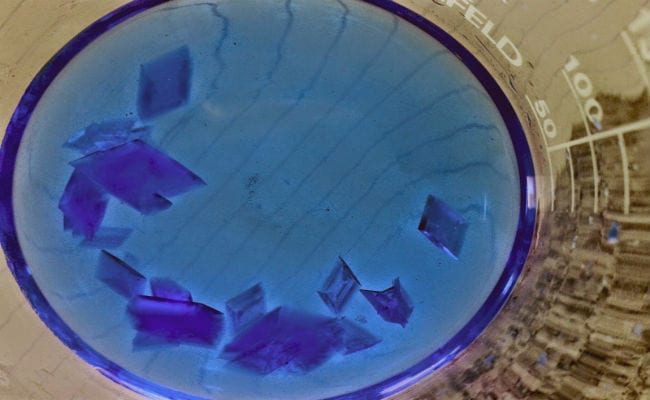Surely you have ever heard about crystals, it is likely that at this point your mind has visualized a huge diamond, an amethyst or a topaz. And certainly, this group also includes many of the well-known "Precious stones", but a crystal is not a denomination that clearly encompasses the field of jewelery.
A crystal is the end product of an interesting process known as crystallization, which is characterized by resulting in a homogeneous solid formed by "faces", which are portions located in different planes.
Characteristics of the solid from crystallization
The size of a crystal is a variable characteristic, in a wide range of dimensions. "Huge" crystals can be found which can be measured through the linear unit "meter", as well as we can find crystals that must be expressed in terms of "microns", since their small size makes them comparable with microorganisms such as bacteria, which are only observable through the microscope.
As mentioned, crystalline processes result in products of high purity, that is why we established, earlier in the definition, that the crystals are homogeneous: that is, the composition of the product remains at a constant value at any point in the volume of the solid, which also implies that the physical and chemical characteristics remain unchanged throughout the piece, and in case of observing variation due to a disturbance , the change will occur throughout the species. This quality makes crystals valuable products in various fields, ranging from the appreciation of the quality of the material, to the use of the crystallization process as a technique to separate substances.
Crystalline products can also be isolated at the laboratory level, through controlled reactions in assemblies that emulate the spontaneous processes that occur in nature. One of the main advantages of the crystals obtained in controlled processes is that they present more regular shapes, which perfectly match the polygonal figures of greater accuracy.
In a crystal, it is necessary to distinguish the faces that are part of the real crystalline habit (morphological characteristics), and based on the number of them, we can consider the fundamental shapes of the solid. Usually in a crystal is defined by the combination of several fundamental shapes, the main ones being the following:
- Pedion: Glass consisting of a single flat face, without equivalents.
- Pinacoid: It is made up of two equivalent faces with respect to an axis of symmetry.
- Sphenoid: The two equivalent faces that make up this solid lie around a binary axis.
- Prism: It is made up of homologous faces that make up a zone. Being the "area of a crystal" defined as a set of faces parallel to the same direction, corresponding to an edge of the same.
The structure of crystals from an internal point of view can be considered to be constituted by a more or less homogeneous, periodic and anisotropic system of a dissolved material that develops a structure at various points in space. Within the characteristics of crystals, interest has always been aroused by the fact that each point have a regular repeat in the space occupied by the material. In crystallography, the phenomenon that influences this action is called translation.
Crystallization process
For a crystallization to occur, we must start from a substance that can be classified as "Crystalline", and this is defined because the particles that make it up, whether they are of an atomic, molecular or ionic nature, have properties of homogeneity, periodicity and symmetry.
The whole process is activated when at some point in the crystalline substance, the particles begin to reorganize, in a stage known as nucleation. This whole process involves, in addition to the evident variation in the order of the particles, a process of change in the thermodynamic conditions, which are oriented to the compensation of the disturbances generated by the change in the Gibbs free energy, which is marked by three events:
- The change in chemical energy.
- The creation of an interface between the nucleation zone and the rest of the homogeneous phase.
- The variation in volume and shape that this process involves triggers tensions.
The next phase originates when the nucleation base structure stabilizes. The next step is something logical and predictable, once we have the basic structure we will enter a process of crecimiento, in which a change in the dimensions of the nucleus is observed. Little by little, this increase will result in the formation of faces, until the crystal acquires a well-defined habit.
Mechanism of crystal growth
The theory developed by Volmer explains how the growth of a crystal takes place, establishing that, around the basic structure from the nucleation of the crystalline substance, a kind of absorption layer, which acts as an interface, and in addition to this, it promotes a migration of particles around it, which move parallel to the surface. The result of this process is defined as a structure defined in a two-dimensional plane.
For their part, Kossel and Straski, determined that mechanical work is required to achieve the fixation of an ion to the surface of this layer, and that it depends on its position.
The development of a model that defines growth requires the forecast of saturation zones where a higher rate of change is observed (local zones of supersaturation). This shows that crystal growth occurs in layers.
Crystallization as a separation mechanism
Since a crystal is formed with a homogeneous substance, its use as a method of selective separation of substances has been extended, among several methods, below, we will explain what those whose use is more widespread consist of:
- Adding a new solvent: If we know the nature of the products we are handling, we can apply this method, which basically consists of adding a new solvent that interacts with the solvent in which the solute that we want to crystallize is immersed. When the new solvent selectively begins to interact with its homologue, the solute precipitates, initiating the crystallization process.
- Cooling to high solute concentrations: When we have a high-concentration solution, which was made at high temperatures, and we submit it to a cooling process, we obtain a condition of supersaturation, in which a greater amount of solute is dissolved than the solvent can accept, in those new temperature conditions. If the process of reducing the temperature is done in a controlled way, we can influence the size of the crystal that we are going to obtain.
- Sublimation: This technique can only be applied in crystalline compounds that present a high vapor pressure, in such a way that the transformations from a gas phase to a solid one do not require the passage through the melting point.

